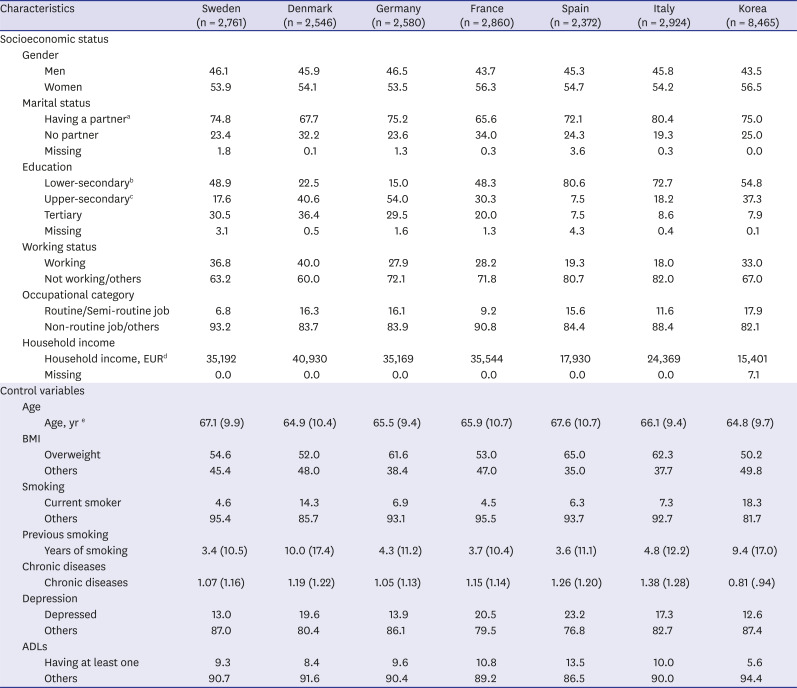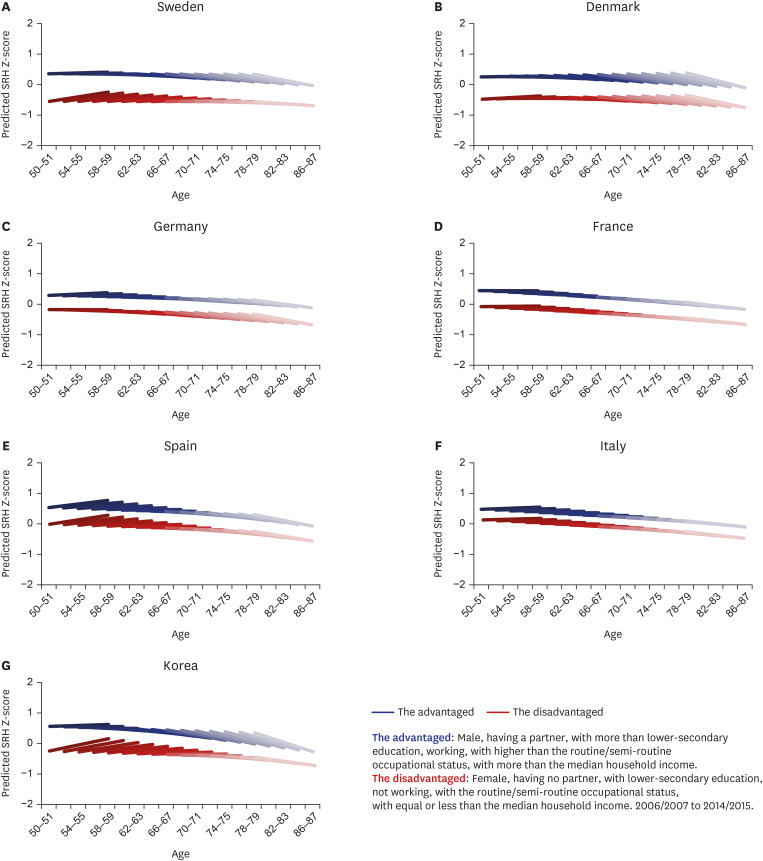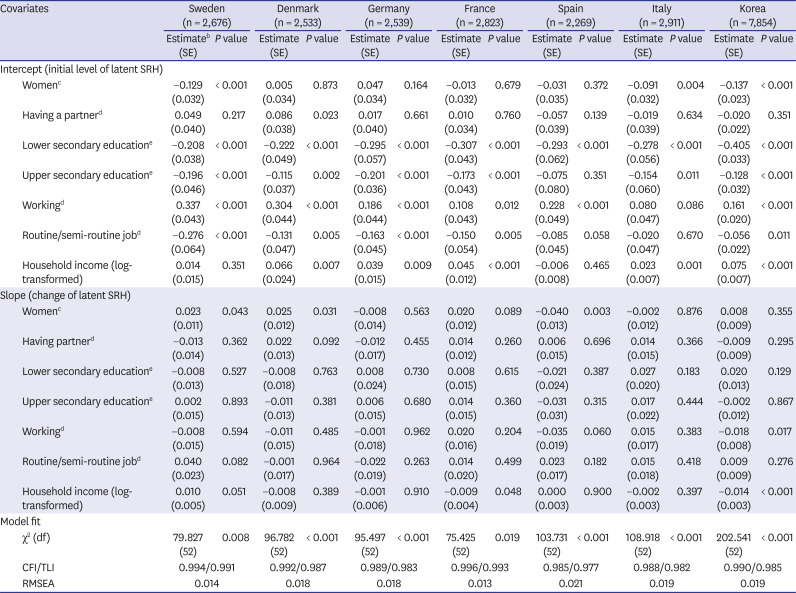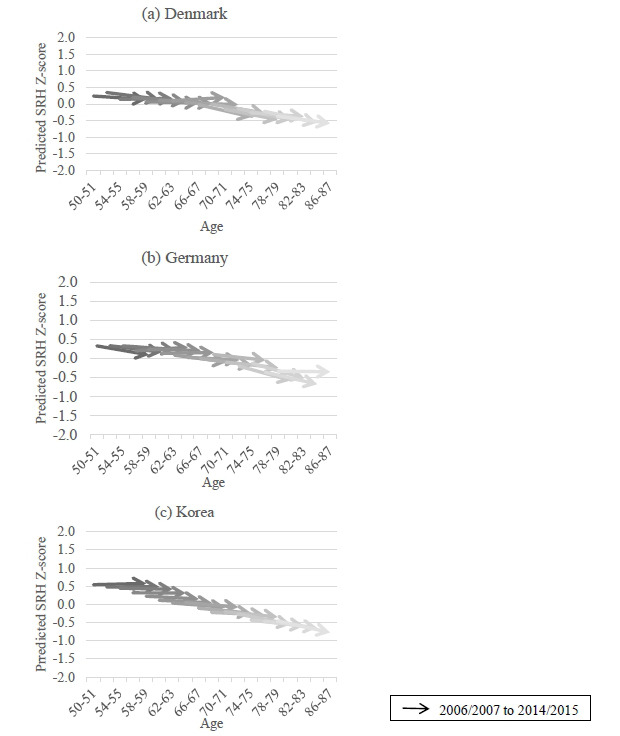1. Marmot M, Allen J, Goldblatt P, Boyce T, Di McNeish M, Grady IG. 2010.
2. Mackenbach JP, Kunst AE, Cavelaars AE, Groenhof F, Geurts JJ. Socioeconomic inequalities in morbidity and mortality in western Europe. The EU Working Group on Socioeconomic Inequalities in Health. Lancet. 1997; 349(9066):1655–1659. PMID:
9186383.
3. Vågerö D, Erikson R. Socioeconomic inequalities in morbidity and mortality in western Europe. Lancet. 1997; 350(9076):516.

4. Tanaka H, Nusselder WJ, Bopp M, Brønnum-Hansen H, Kalediene R, Lee JS, et al. Mortality inequalities by occupational class among men in Japan, South Korea and eight European countries: a national register-based study, 1990-2015. J Epidemiol Community Health. 2019; 73(8):750–758. PMID:
31142611.

5. Di Cesare M, Khang YH, Asaria P, Blakely T, Cowan MJ, Farzadfar F, et al. Lancet NCD Action Group. Inequalities in non-communicable diseases and effective responses. Lancet. 2013; 381(9866):585–597. PMID:
23410608.

6. Sacker A, Worts D, McDonough P. Social influences on trajectories of self-rated health: evidence from Britain, Germany, Denmark and the USA. J Epidemiol Community Health. 2011; 65(2):130–136. PMID:
19996360.

7. McDonough P, Worts D, Sacker A. Socioeconomic inequalities in health dynamics: a comparison of Britain and the United States. Soc Sci Med. 2010; 70(2):251–260. PMID:
19857919.

8. Esping-Andersen G. The Three Worlds of Welfare Capitalism. Princeton, NJ: Princeton University Press;1990.
9. Ferrera M. The ‘Southern model’ of welfare in social Europe. J Eur Soc Policy. 1996; 6(1):17–37.

10. Holliday I. Productivist welfare capitalism: social policy in East Asia. Polit Stud. 2000; 48(4):706–723.

11. Ebbinghaus B. Comparing Welfare State Regimes: Are Typologies an Ideal or Realistic Strategy? Edinburg: ESPAN;2012. p. 1–20.
12. Abdul Karim S, Eikemo TA, Bambra C. Welfare state regimes and population health: integrating the East Asian welfare states. Health Policy. 2010; 94(1):45–53. PMID:
19748149.

13. United Nations Development Programme. Human Development Report 2016. New York, NY: United Nations Development Programme;2016.
14. Bahk J, Lynch JW, Khang YH. Forty years of economic growth and plummeting mortality: the mortality experience of the poorly educated in South Korea. J Epidemiol Community Health. 2017; 71(3):282–288. PMID:
27707841.

15. Tilly C. Big structures, Large Processes, Huge Comparisons. New York, NY: Russell Sage Foundation;1984.
16. Kim IH, Muntaner C, Vahid Shahidi F, Vives A, Vanroelen C, Benach J. Welfare states, flexible employment, and health: a critical review. Health Policy. 2012; 104(2):99–127. PMID:
22137444.

17. Börsch-Supan A, Jürges H. The Survey of Health, Ageing and Retirement in Europe – Methodology. Mannheim: Mannheim Research Institute for the Economics of Aging (MEA);2005.
19. Bergmann M, Kneip T, De Luca G, Scherpenzeel A. SHARE Working Paper Series. Survey Participation in the Survey of Health, Ageing and Retirement in Europe (SHARE), Wave 1–7. Munich: SHARE-ERIC;2019.
21. Idler EL, Benyamini Y. Self-rated health and mortality: a review of twenty-seven community studies. J Health Soc Behav. 1997; 38(1):21–37. PMID:
9097506.

22. Mavaddat N, Parker RA, Sanderson S, Mant J, Kinmonth AL. Relationship of self-rated health with fatal and non-fatal outcomes in cardiovascular disease: a systematic review and meta-analysis. PLoS One. 2014; 9(7):e103509. PMID:
25076041.

23. Haas S. Trajectories of functional health: the ‘long arm’ of childhood health and socioeconomic factors. Soc Sci Med. 2008; 66(4):849–861. PMID:
18158208.

24. Wickrama KK, Mancini JA, Kwag K, Kwon J. Heterogeneity in multidimensional health trajectories of late old years and socioeconomic stratification: a latent trajectory class analysis. J Gerontol B Psychol Sci Soc Sci. 2013; 68(2):290–297. PMID:
23197341.

25. Liang J, Quiñones AR, Bennett JM, Ye W, Xu X, Shaw BA, et al. Evolving self-rated health in middle and old age: how does it differ across Black, Hispanic, and White Americans? J Aging Health. 2010; 22(1):3–26. PMID:
19952367.

26. Yoo JP, Yoo MS. Impact of childhood socioeconomic position on self‐rated health trajectories of South Korean adults. Asian Soc Work Policy Rev. 2016; 10(1):142–158.

29. Muntaner C, Davis O, McIsaack K, Kokkinen L, Shankardass K, O'Campo P. Retrenched welfare regimes still lessen social class inequalities in health: a longitudinal analysis of the 2003–2010 EU-SILC in 23 European countries. Int J Health Serv. 2017; 47(3):410–431. PMID:
28649927.
30. Popham F, Dibben C, Bambra C. Are health inequalities really not the smallest in the Nordic welfare states? A comparison of mortality inequality in 37 countries. J Epidemiol Community Health. 2013; 67(5):412–418. PMID:
23386671.

31. Sekine M, Chandola T, Martikainen P, Marmot M, Kagamimori S. Socioeconomic inequalities in physical and mental functioning of British, Finnish, and Japanese civil servants: role of job demand, control, and work hours. Soc Sci Med. 2009; 69(10):1417–1425. PMID:
19767137.

32. Korea Labor Institute. First Guide on Generated Variables for KLoSA Wave 1. Seoul: Korea Labor Institute;2007.
34. Mirowsky J, Kim J. Graphing age trajectories. Sociol Methods Res. 2007; 35(4):497–541.

35. Hu LT, Bentler PM. Cutoff criteria for fit indexes in covariance structure analysis: conventional criteria versus new alternatives. Struct Equ Modeling. 1999; 6(1):1–55.

36. Mackenbach JP, Stirbu I, Roskam AJ, Schaap MM, Menvielle G, Leinsalu M, et al. Socioeconomic inequalities in health in 22 European countries. N Engl J Med. 2008; 358(23):2468–2481. PMID:
18525043.

37. Leão T, Campos-Matos I, Bambra C, Russo G, Perelman J. Welfare states, the Great Recession and health: trends in educational inequalities in self-reported health in 26 European countries. PLoS One. 2018; 13(2):e0193165. PMID:
29474377.

38. Cambois E, Solé-Auró A, Brønnum-Hansen H, Egidi V, Jagger C, Jeune B, et al. Educational differentials in disability vary across and within welfare regimes: a comparison of 26 European countries in 2009. J Epidemiol Community Health. 2016; 70(4):331–338. PMID:
26546286.

39. Mäki N, Martikainen P, Eikemo T, Menvielle G, Lundberg O, Östergren O, et al. Educational differences in disability-free life expectancy: a comparative study of long-standing activity limitation in eight European countries. Soc Sci Med. 2013; 94:1–8. PMID:
23931939.

40. Bakhtiari E, Olafsdottir S, Beckfield J. Institutions, incorporation, and inequality: the case of minority health inequalities in Europe. J Health Soc Behav. 2018; 59(2):248–267. PMID:
29462568.

41. Bartley M. Health Inequality: an Introduction to Concepts, Theories and Methods. Chichester: John Wiley & Sons;2016.
42. Lee SSY. A comparative study on unemployment insurance, social assistance and ALMP in OECD countries. Korean Soc Policy Rev. 2018; 25(1):345–375.
43. Kim YT, Suh JW, Park YJ. The effect of poverty reduction by public pension - a comparative study of 34 OECD countries. Korean Soc Policy Rev. 2018; 25(4):301–321.
45. Rugulies R, Aust B, Burr H, Bültmann U. Job insecurity, chances on the labour market and decline in self-rated health in a representative sample of the Danish workforce. J Epidemiol Community Health. 2008; 62(3):245–250. PMID:
18272740.

46. Choi YJ, Kim HY. Analyzing changes and determinants of self-rated health during adolescence: a latent growth analysis. Child Health Nurs Res. 2018; 24(4):496–505.

47. Kim Y, Jeong M. Predictors of physical health trajectory among middle- and older adults - focusing on impacts of retirement characteristics. J Community Welf. 2018; 64(3):1–24.
48. World Economic Forum. The Global Gender Gap Report 2017. Geneva: World Economic Forum;2017.
49. Palència L, De Moortel D, Artazcoz L, Salvador-Piedrafita M, Puig-Barrachina V, Hagqvist E, et al. Gender policies and gender inequalities in health in Europe: results of the SOPHIE project. Int J Health Serv. 2017; 47(1):61–82. PMID:
27530991.
50. Olafsdottir S. Gendered health inequalities in mental well-being? The Nordic countries in a comparative perspective. Scand J Public Health. 2017; 45(2):185–194. PMID:
28077063.

51. Hanibuchi T, Nakaya T, Murata C. Socio-economic status and self-rated health in East Asia: a comparison of China, Japan, South Korea and Taiwan. Eur J Public Health. 2012; 22(1):47–52. PMID:
21113030.

52. Lundberg O, Yngwe MÅ, Stjärne MK, Elstad JI, Ferrarini T, Kangas O, et al. The role of welfare state principles and generosity in social policy programmes for public health: an international comparative study. Lancet. 2008; 372(9650):1633–1640. PMID:
18994660.

53. Högberg B. Gender and health among older people: what is the role of social policies? Int J Soc Welf. 2018; 27(3):236–247.

54. Shuey KM, Willson AE. Cumulative disadvantage and black-white disparities in life-course health trajectories. Res Aging. 2008; 30(2):200–225.










 PDF
PDF Citation
Citation Print
Print




 XML Download
XML Download